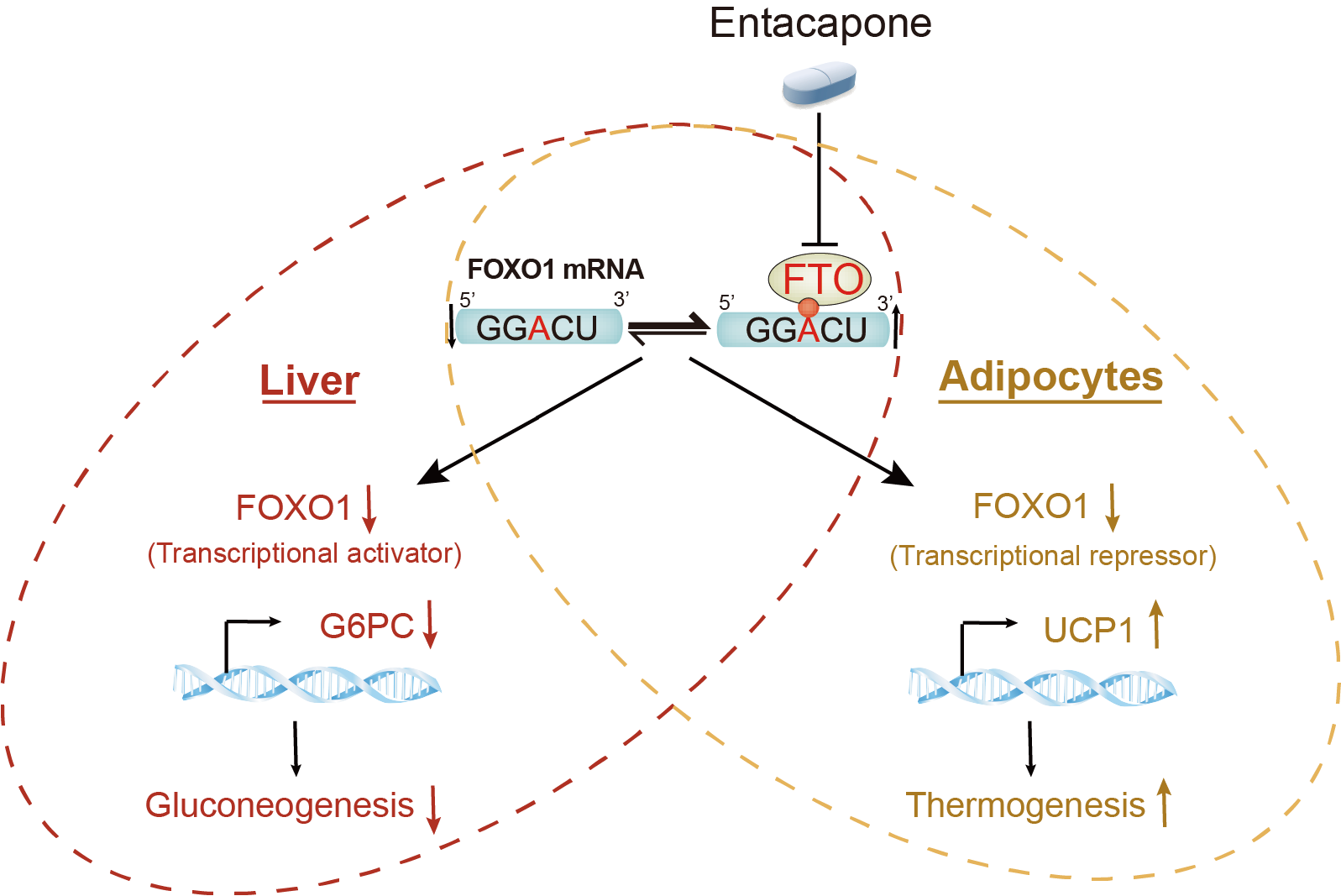The Fat-Mass and Obesity-Associated gene (FTO) was the first identified genetic factor for obesity. FTO plays a vital role in regulation of body weight and fat mass, however, the molecular mechanism for its regulation in obesity and the potential clinically approved drugs that can specifically inhibit its enzymatic activity are not well understood. A cooperative study led by Dr. HUANG Niu at National Institute of Biological Sciences and Dr. YANG Yungui at Beijing Institute of Genomics, Chinese Academy of Sciences, has revealed how entacapone, a FDA proved drug for Parkinson's disease, regulates energy homeostasis and body weight through inhibiting FTO’s demethylation activity on m6A. This work has been published in Science Translational Medicine with title ‘Identification of entacapone as a chemical inhibitor of FTO mediating metabolic regulation through FOXO1’on April 17. m6A is the most abundant internal mRNA modification in mRNA participating in various biological processes, such as development of mammal, immunology, stem cell renewal, adipocyte cell differentiation, tumorigenesis and metastasis, etc. In this work, a structure-based virtual screening approach was employed to discover that entacapone can directly inhibit the demethylation activity of FTO. The functional investigation of entacapone was carried out in entacapone-treatment and liver-specific FTO knockout mice. They observed that entacapone feeding mice exhibited some features of reprogrammed energy metabolism, such as body weight loss, lower fasting blood glucose levels and thermogenesis increase in adipose tissues. Mechanistically, transcriptome analysis revealed that G6CP, the critical gene in gluconeogenesis, was downregulated in FTO knockdown cells. Based on the transcriptome and m6A-IP seq analyses on liver tissue isolated from liver-specific FTO conditional knockout mice, they further demonstrated that the downregulation of FOXO1 protein in FTO conditional KO mice was due to the increased m6A level in its mRNA. To further determine how FTO regulates the expression of G6PC, they used adenovirus system to integrate G6PC promoter-luciferase reporter gene into the mouse liver to monitor the in vivo luciferase signal. Mice with conditional knock-out of FTO or FOXO1 in liver, or Entacapone feeding displayed reduced luciferase signal, which can be restored by WT-FTO but not m6A catalytic domain mutant FTO. These experiments illustrate the important role of FTO-FOXO1-G6PC regulatory axis in regulation of gluconeogenesis in liver. Furthermore, this study revealed that the molecular mechanism of elevated thermogenesis in mouse iWAT (inguinal white adipose tissue). They found that FTO inhibition by entacapone upregulates m6A level in FOXO1 mRNA leading to the downregulated protein abundance of FOXO1. UCP1 promoter-luciferase assay further illustrated that the level of m6A deposited in FOXO1 mRNA affects the expression of UCP1. FOXO1 acts as a transcription repressor inhibiting the expression of UCP1 in iWAT, which is apparently different from its function in liver. This work elucidated the molecular mechanism through which FTO regulating gluconeogenesis in liver and thermogenesis in iWAT. The discovery of FTO inhibitor-entacapone is potentially significant in the guidance and further development of clinic drugs for obesity patients. This work was supported by the Strategic Priority Research Program A of the Chinese Academy of Sciences, the National Basic Research Program of China and the National Natural Science Foundation of China. The proposed FTO-FOXO1 regulatory axis in adipose tissues and liver (Image by NIU Huang) Contact: Dr. YANG Yungui Email: ygyang@big.ac.cn CAS Key Laboratory of Genomic and Precision Medicine (http://english.big.cas.cn/)
